Silver from the Historical collections
Select an image for more information
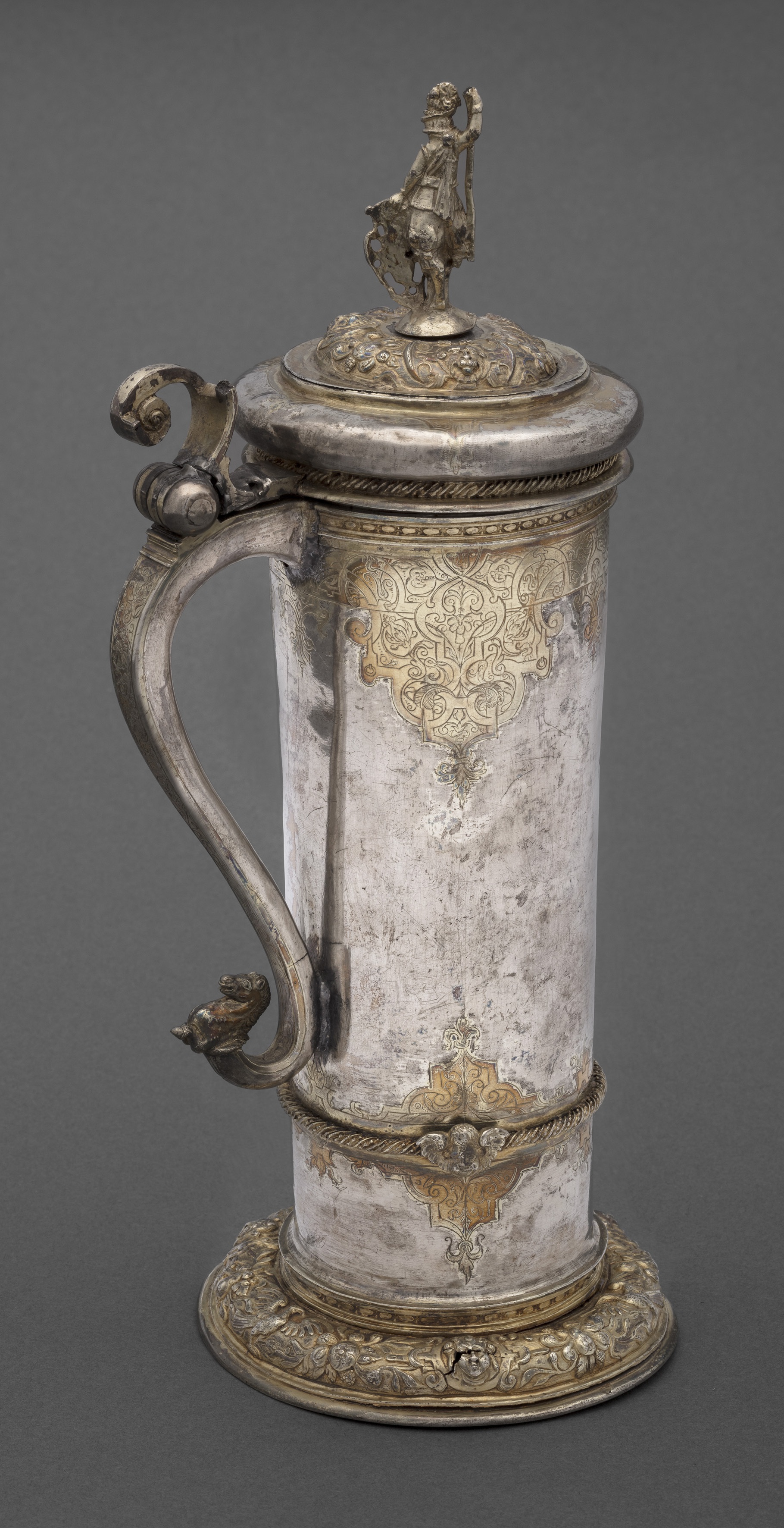
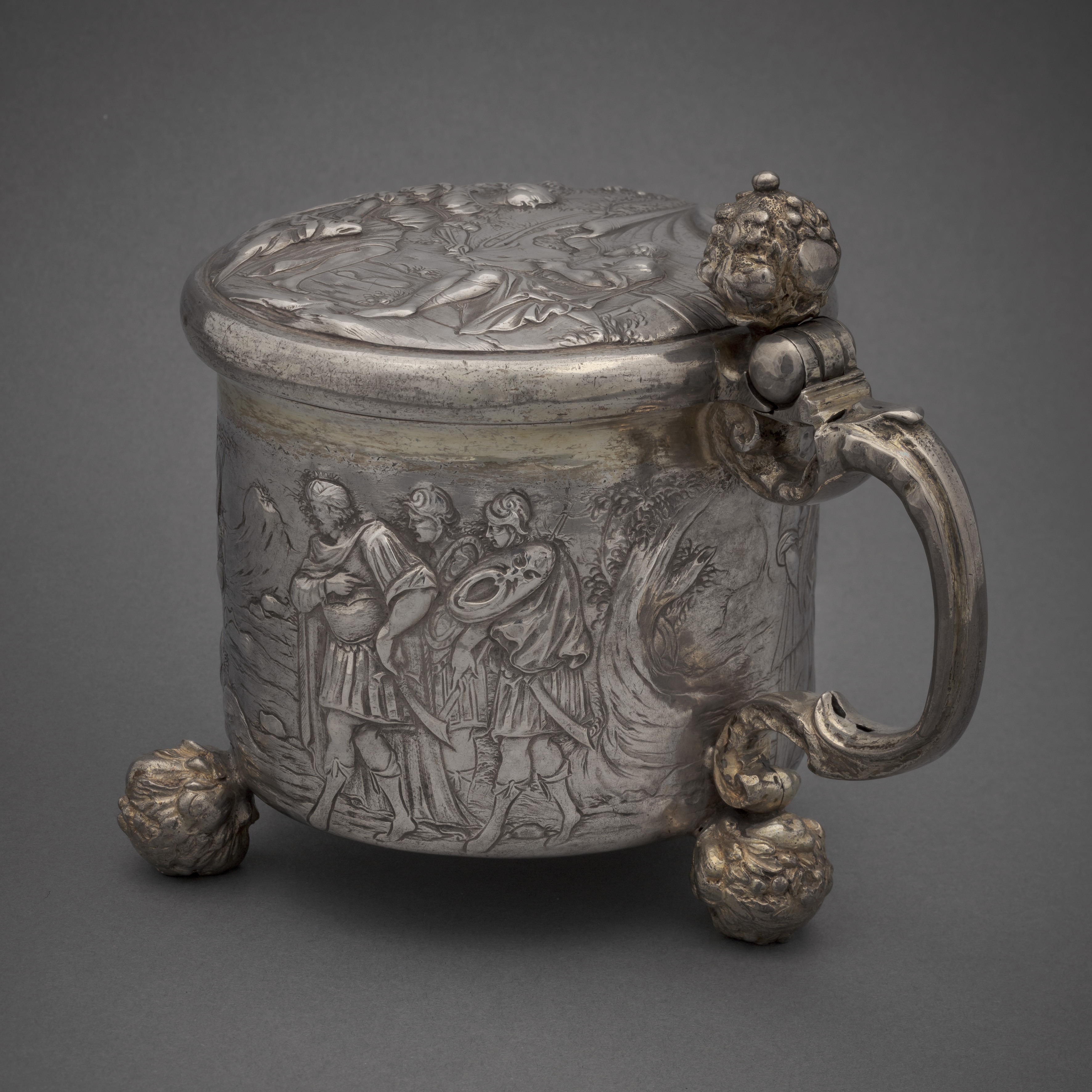
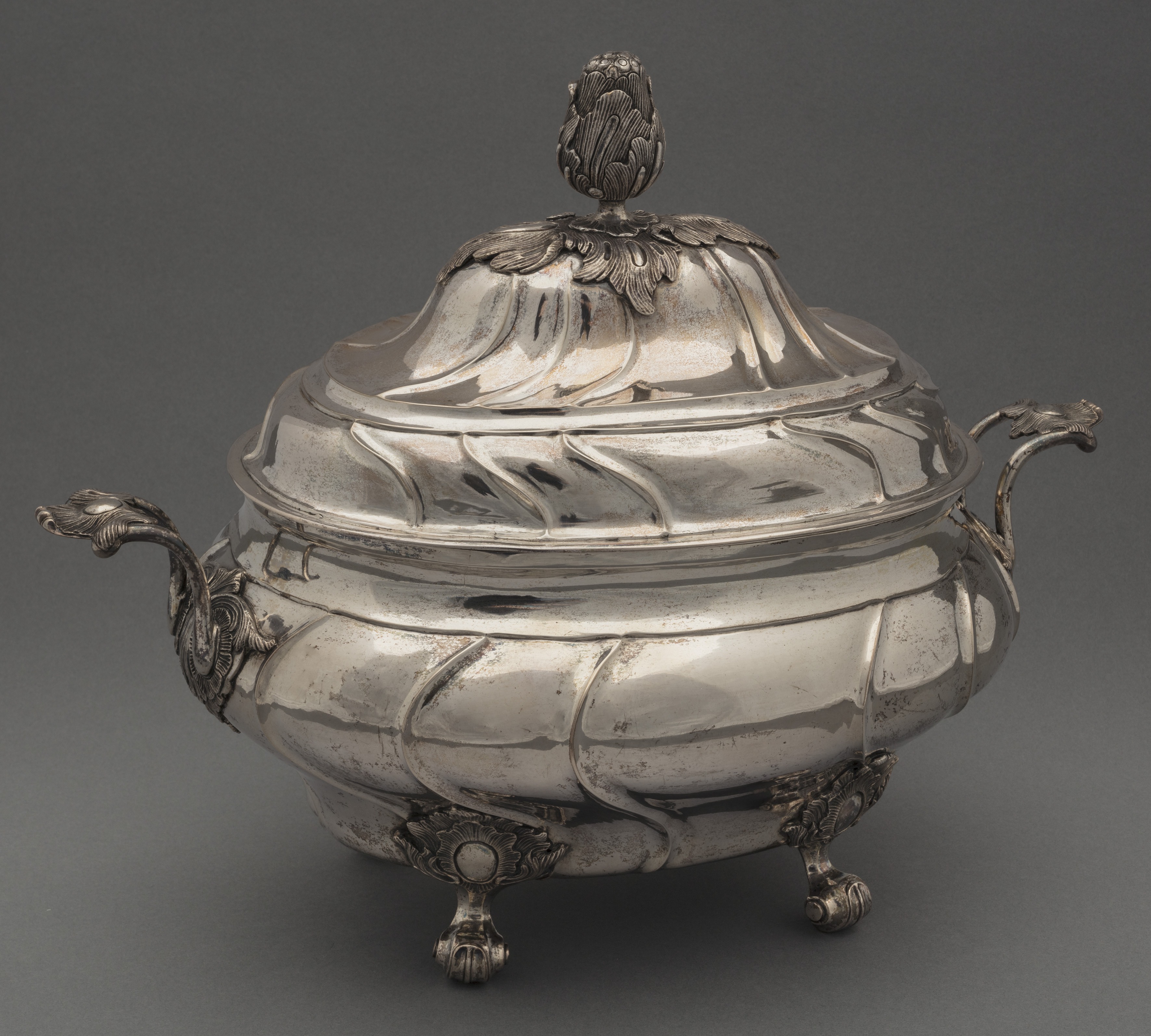
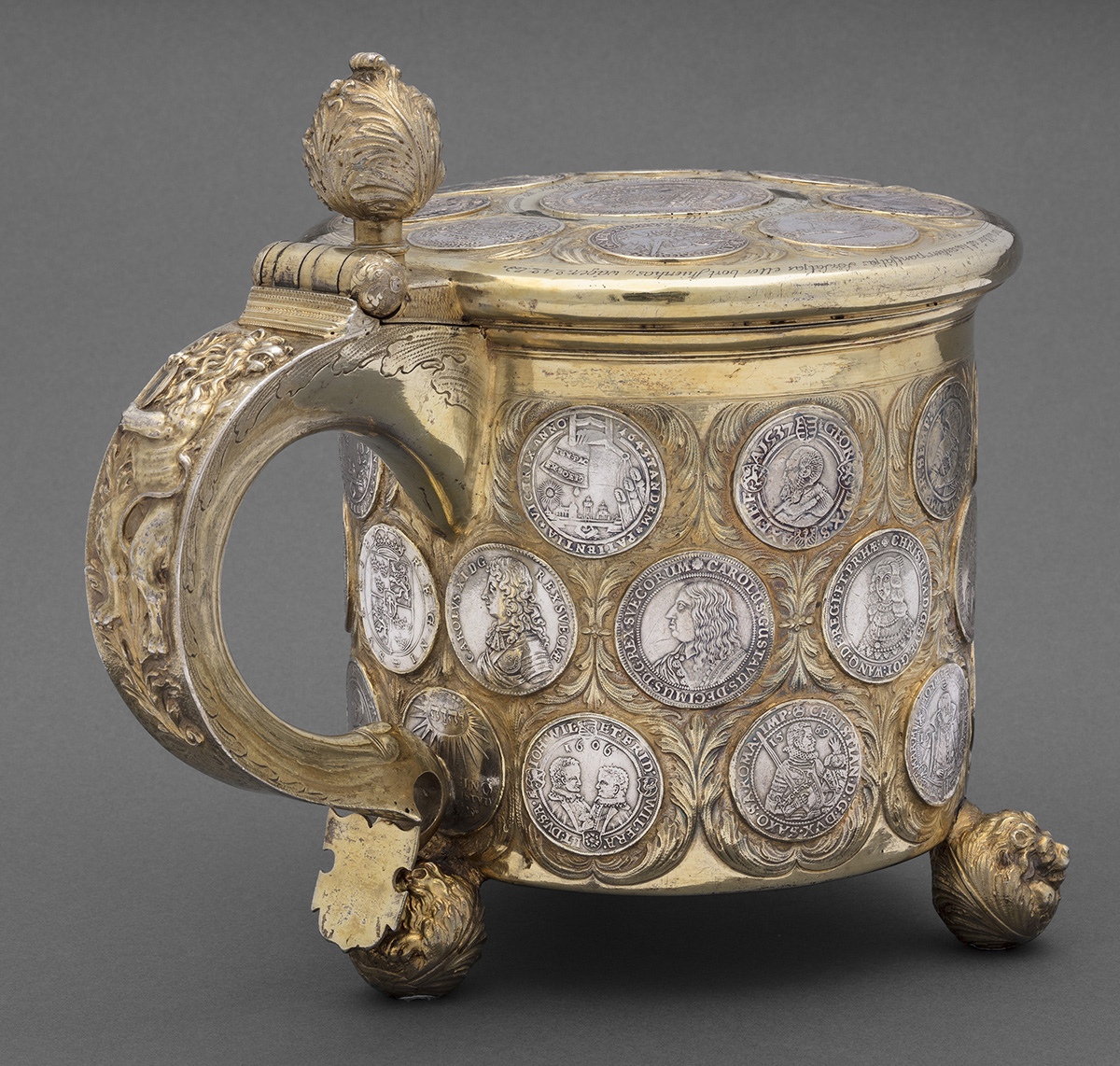
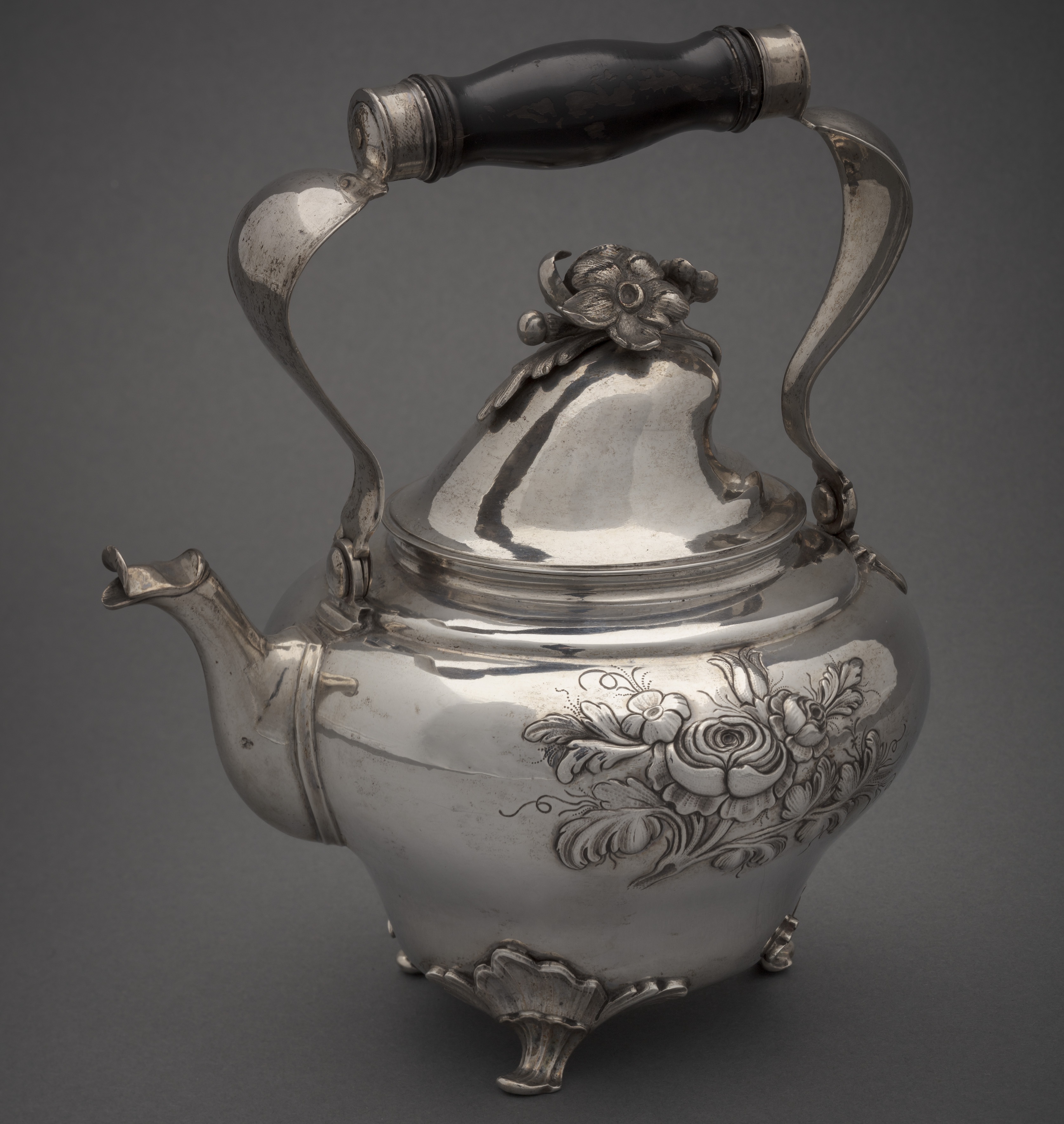
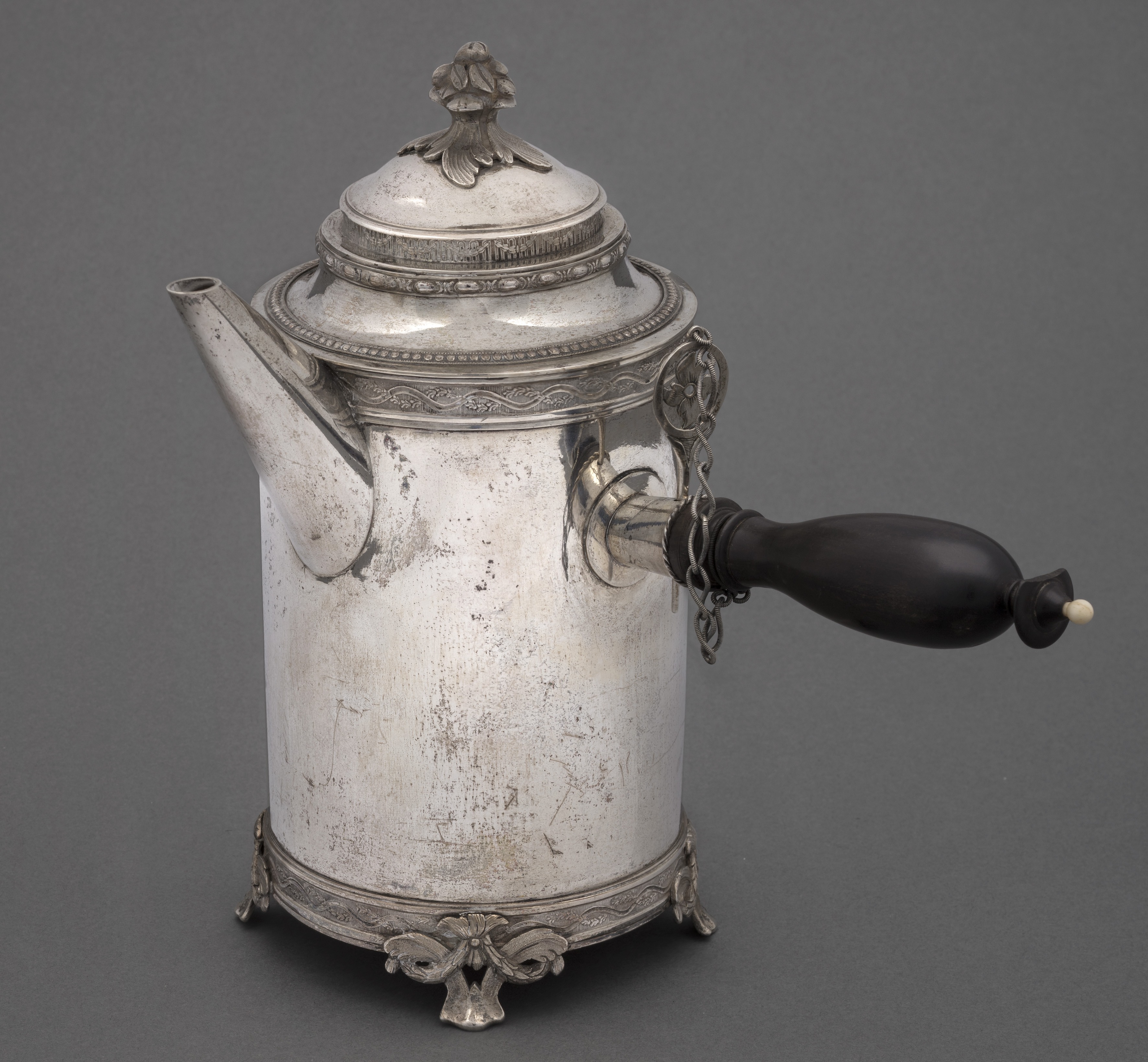
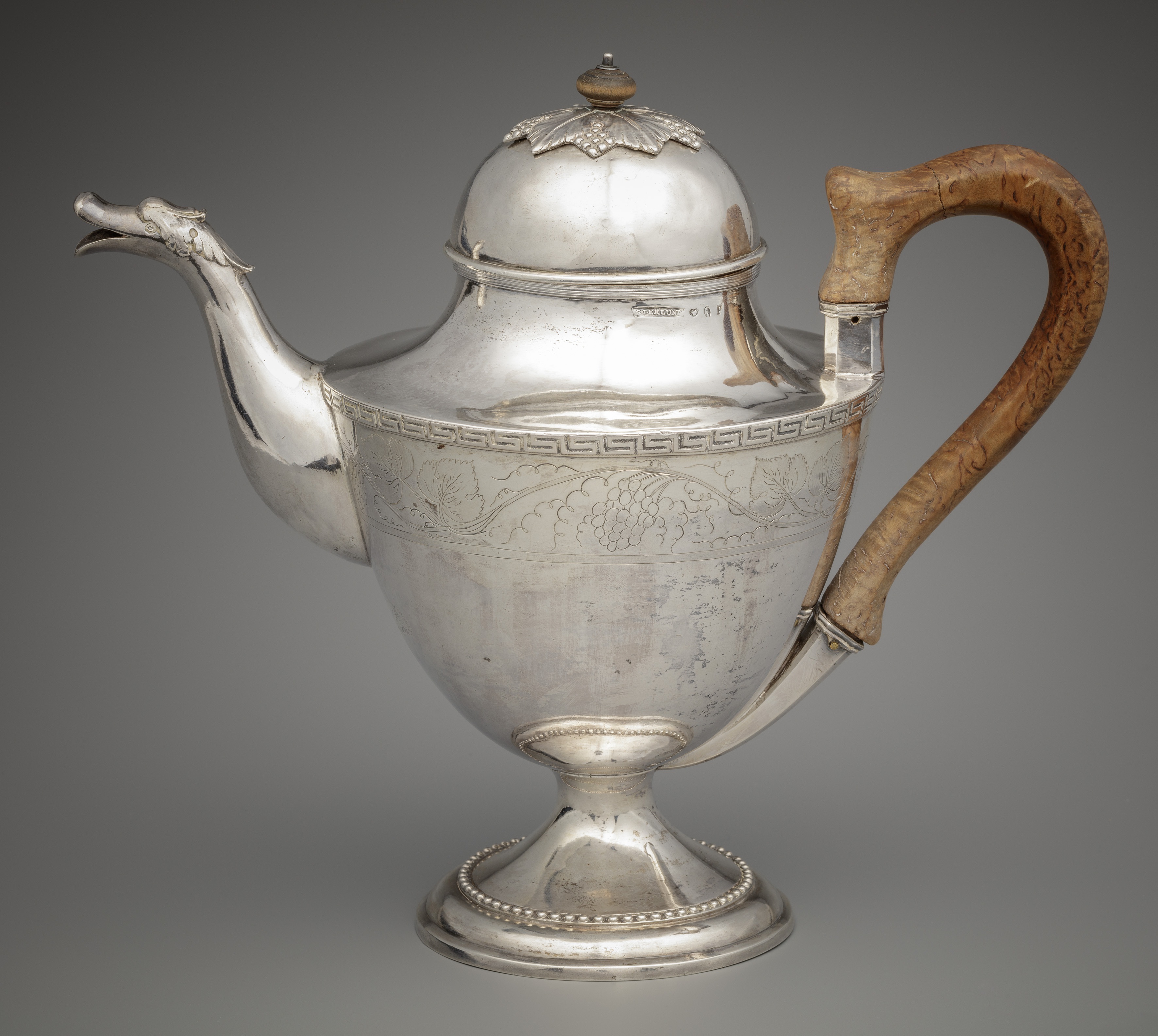
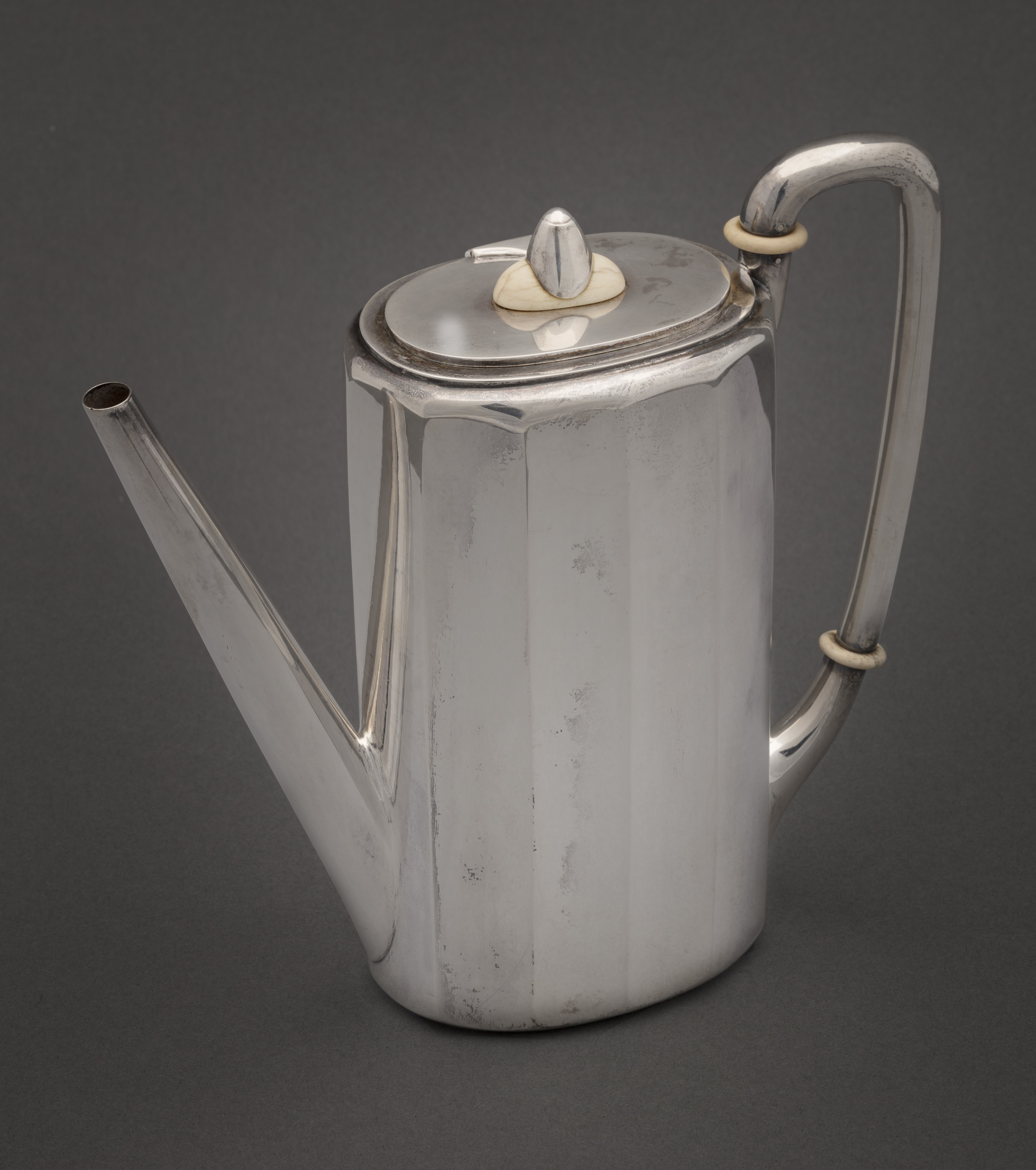


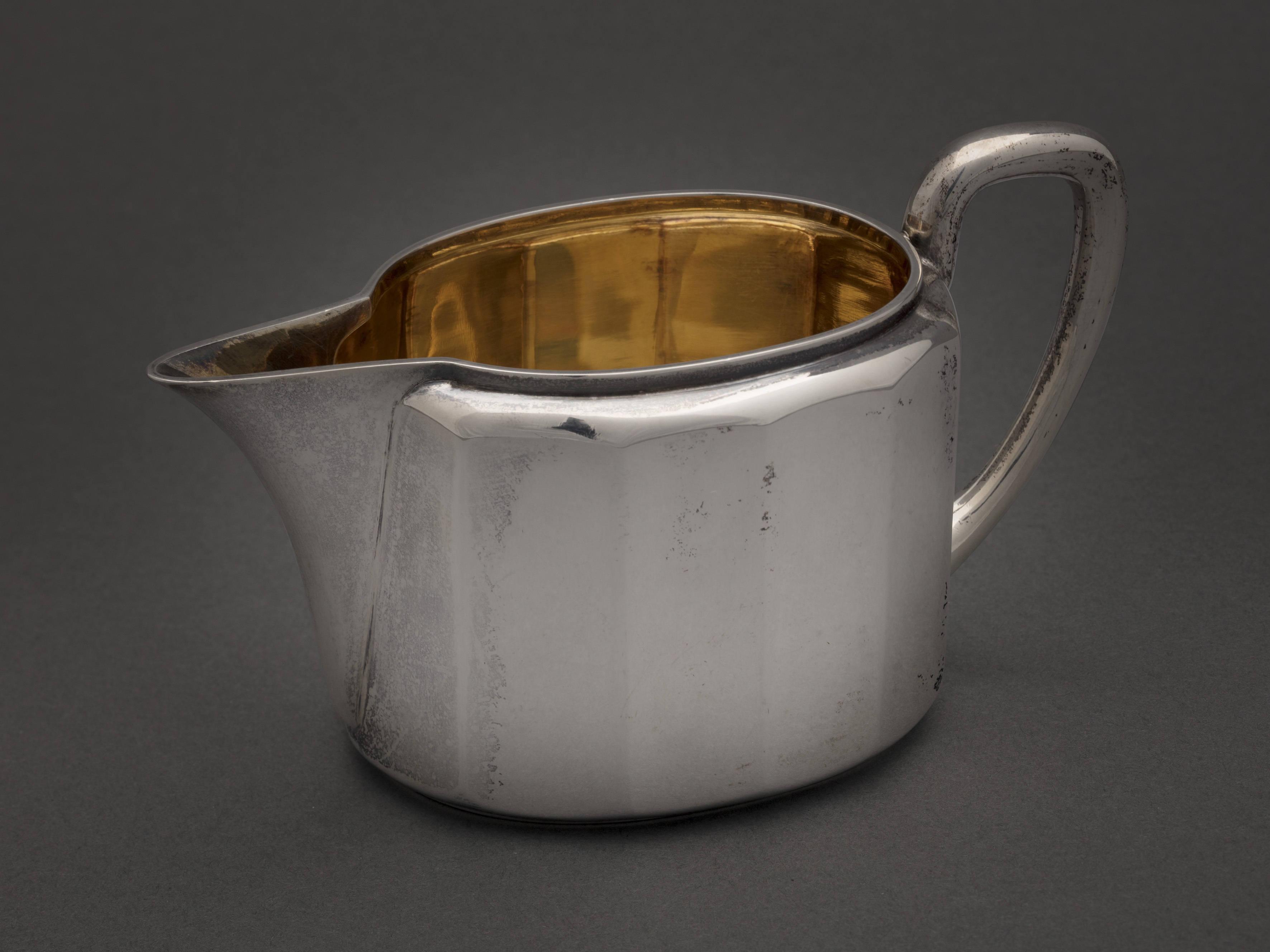
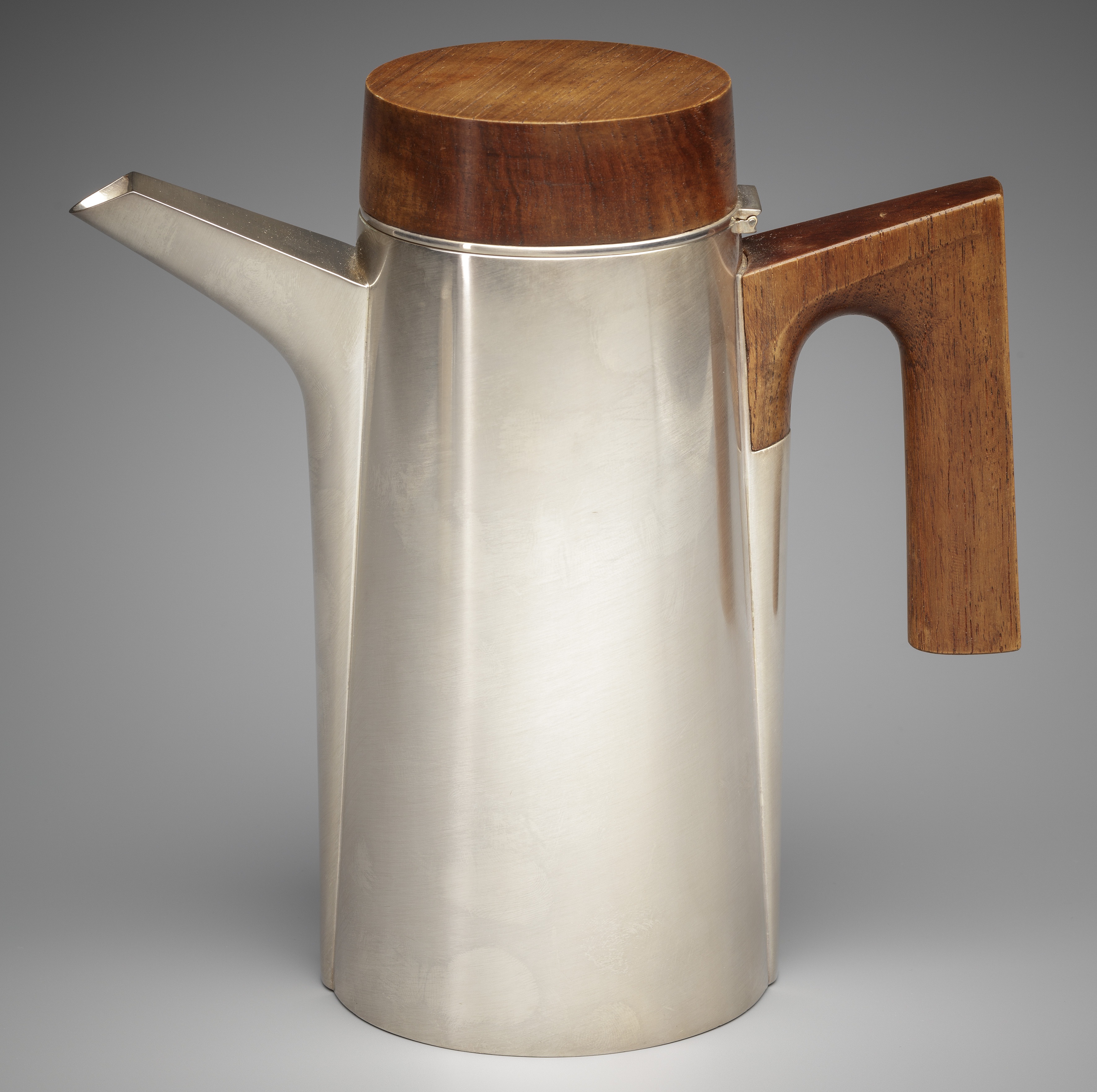
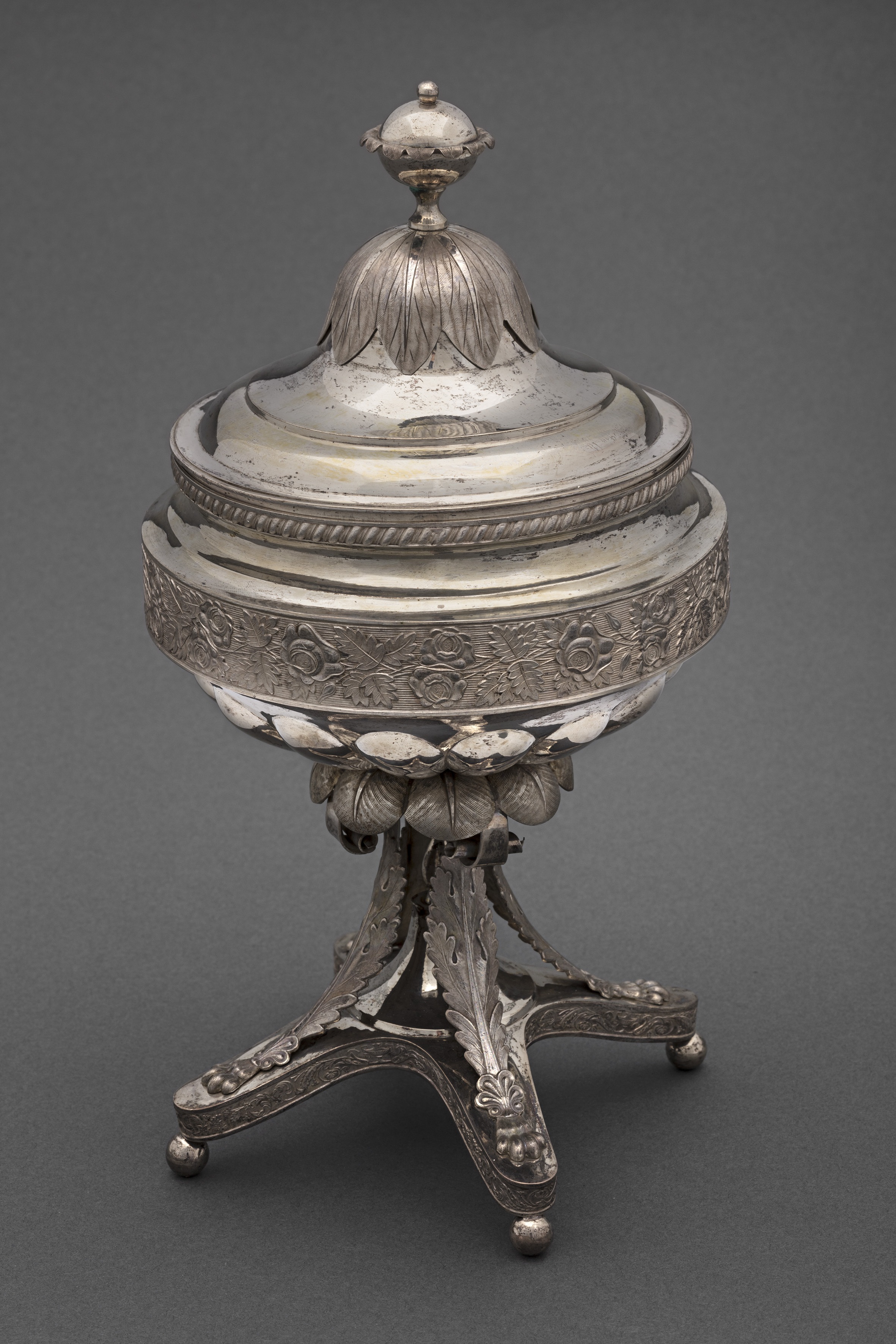
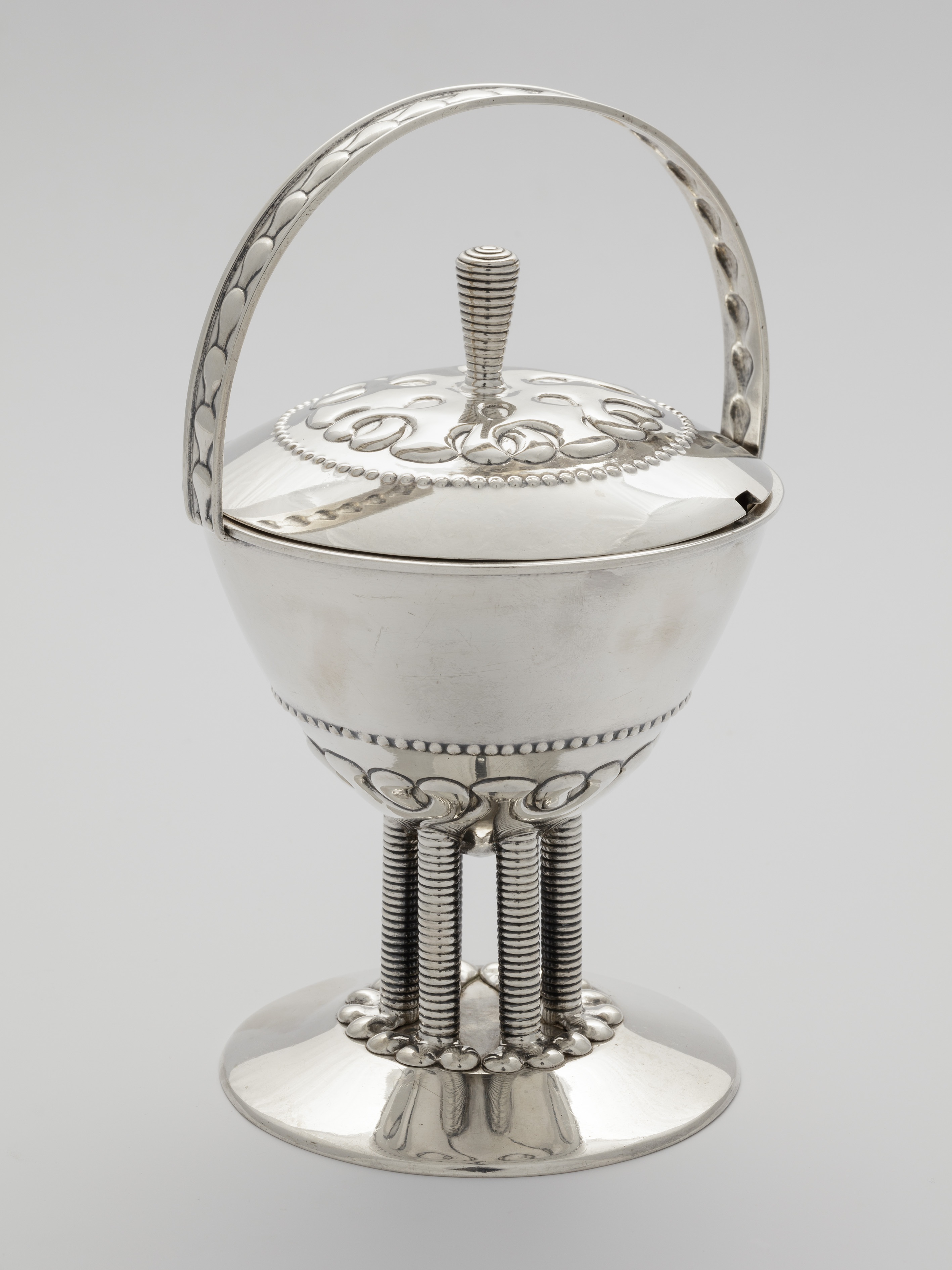
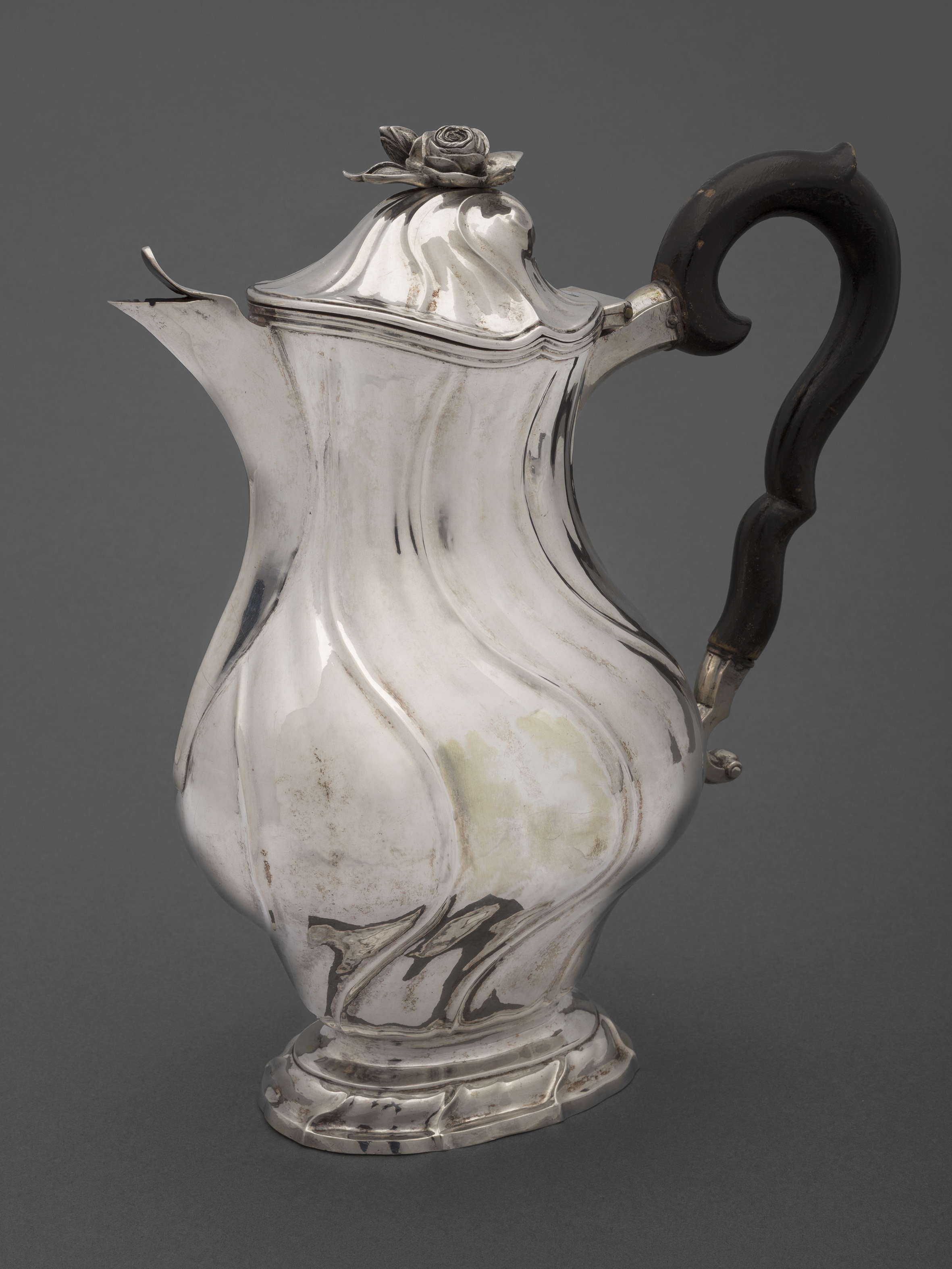
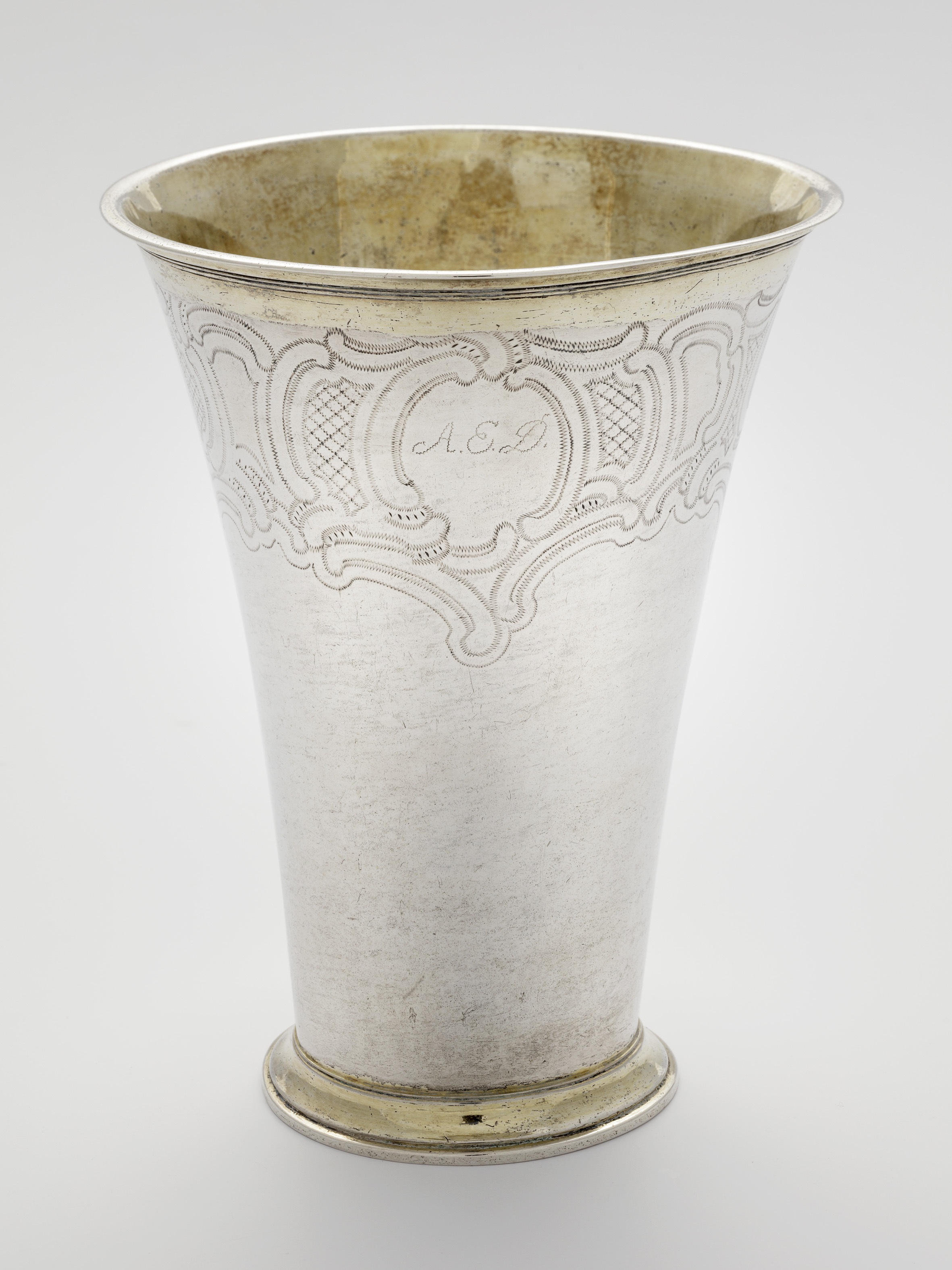
Tankard, so-called Hanse tankard
Tankard
Soup tureen
Tankard
Tea pot
Coffee pot
Coffee pot
Coffee set (coffee pot)
Chalice from Iijoki church
Coffee set (sugar bowl)
Coffee set (creamer)
Coffee pot
Sugar bowl
Bowl with lid
Coffee pot
Beaker

Tankard, so-called Hanse tankard
Tallinn (Reval), Estonia, late 16th century. Height 23 cm.
This tankard is used like a pint; that is, people have drunk directly from it. Tankards were mainly meant for drinking beer, but sometimes also wine. The cylindrical, tall and narrow shape is typical of a tankard from the end of the 16th century. The name “Hanse tankard” refers to the Hanseatic Lague, which was formed by coastal cities by the Baltic Sea and operated as early as the Middle Ages, and to the fact that similar tankards were used by wealthy Hanse merchants in festivities in different regions around the Baltic Sea.
This tankard was made in Tallinn, and its Renaissance-style ornamentation, gilded and partly engraved and partly cast, highlights the value and festive appearance of the tankard. The soldier standing on top of the tankard has likely held in his right hand a flag, the pole of which has remained only partly intact. The shield that the soldier is carrying at his side is possibly intended more for parades than for battle.
The tankard is a part of a silver hoard found in Nivala. The hoard was discovered by Leonard Antinpoika Mustakangas, the son of a tenant farmer, in 1891, buried in the ground in Kolmikangas, Nivala. Based on the other silver objects, a beaker, a mug and spoons, the objects were likely hidden during the Great Wrath in 1713–1721. Several hoards have been found in Finland consisting usually of copper coins or silver coins and objects, buried in the ground during wars and crises.
Source:
Fagerström 2000, s. 12–13.



Digital collection

Tankard
Abraham Carré, Stockholm, or Hans Meijer, Turku, between 1694–1716. Height 14 cm.
This tankard is a German-style baroque tankard with ample embossed decorations. The cylindrical body, even lid, three spherical feet and thumb rest in the lid are all typical baroque tankard features. The tankard is also regular in size; baroque tankards were made in different sizes, ranging from small tankards that hold a few decilitres to impressive luxury items that hold several litres. Tankards were usually meant for drinking beer.
This tankard has marks from both Abraham Carré from Stockholm and Hans Meijer from Turku. It is unclear how Hans Meijer contributed to making the tankard. Meijer was an assay master in Turku in 1695–1716, so the mark might be his hallmark to denote he assayed the silver content of the tankard.
A motif has been embossed onto the side, copied on the basis of Matthäus Merian the Elder’s engraving (1630), depicting Dido, the Queen of Carthage, acquiring the territory to found the city of Carthage. Floral motifs were often used in the embossed decorations of tankards during the Baroque, but some tankards also had smooth sides, with the decorations centred on the cast parts and the lid.
32100:1 Collection Aspelin-Haapkylä
Sources:
Fagerström 2000, s. 38–39. Borg 1972 (1935), s. 55–57.
Kuurne 2018, s. 66–67.






Digital collection

Soup tureen
Nils Enberg, Turku, 1766. Height 35 cm.
This tureen, which takes perfect advantage of rococo forms, has a strongly protuberant bowl, and the lid has been divided into sectors with wave lines, typical of rococo. The cartouche-like feet and the handles at the ends are cast, as is the plastic asparagus tip serving as a knob on top of the lid.
Nils Enberg (active in Turku in 1752–1779) began as an apprentice in Stockholm and gained his journeyman’s qualifications in 1746. When Johan Wittfooth moved to Sweden in 1752, Enberg managed his workshop and conducted his masterwork in 1752. Enberg’s widow continued the practice in 1779–1782, while their son Nils Enberg practiced as a journeyman. The rococo objects made by Nils Enberg are among the silver objects with the highest quality made in Turku. This soup tureen is the most extravagant silver object made in Finland in the 18th century.
The soup tureen originally belonged to the governor of Kymmenegård County, Lieutenant Colonel Johan Herman Lode (1739–1817). The Finnish Government bought the soup tureen in 1975 and gave it to President of the Republic Urho Kekkonen when he turned 75.
Source:
Fagerström 2000, s. 62–63. Borg 1972 (1935), s. 70–71.



Digital collection

Tankard
Johan Nützel, Stockholm, 1695. Height 21 cm.
The lid, bottom and sides of this unusually large cylindrical tankard are inlaid with a total of 45 silver coins, the backs of which are visible inside the tankard. The outer surface is, apart from the coins, gilded, and the inner surface is entirely gilded. There are 24 Swedish coins, 20 German coins, and one Danish coin. The oldest coin is a Saxon thaler from 1530 (George the Bearded, Duke of Saxony), the youngest coin is a Swedish riksdaler of Charles XI from 1676. Some of them are commemorative coins.
Due to the size and high quality of the handicraft, the tankard is intended not only to demonstrate the wealth of its owner but also to display the goldsmith’s skills, more than for real daily use. The way the coins have been curved to fit the surface and how the surface has been thoroughly filled with a relief of vine leaves demonstrate skilled craftmanship. The abundant gilding is also telling of the wealth used on the tankard.
The loop-shaped handle is rectangular in cross-section and ends on the bottom with a shieldlike widening. At the top part of the handle, there is a relief of a shield-bearing lion, as well as a plastically shaped spherical knob which depicts a lion hidden between leaves about to attack. The spherical feet with leaf decorations and lion motifs resemble the knob in the handle.
The tankard, made by Johan Nützel, is unusually large and holds several litres, so that filled with beer, drinking from it would be hard due to the weight (the tankard itself weighs over 3.2 kg).
The bottom of the tankard has an engraved, exceptionally wordy Latin signature by the maker, which also reveals the commissioner and time of production: me fecit et concinnavit Holmiae Joh. Nissel pro. Joh. Philippo Kilbergero secr. et not. publ. eiusque uxore Euphros. Mar. Belocew mence maio anno 1695 (“I was made and designed in Stockholm by Johan Nützel for the secretary and notary public Johan Philipp Kilberger and his spouse Euphrosyne Maria Belocew in May 1695”). The tankard was undoubtedly made for wedding celebrations.
The later owners of the tankard have also recognised its exceptionality and value, which is evident in the engraving added to the lid, in which the tankard, along with some other silver objects, was determined to be inherited entailed (i.e. undivided inheritance) in a household providing riding stables to the army, located in Katainen (Östansjö) in Taivassalo: Handelsmannen och Notfiskare Ålerman i Stockholm Högachtad herr Johan Österman, föd d. 24: Junii 1695 död d. 23 September 1764 Testamenterar denna Silf[ve]r kanna til Rusthållet Östansiö i Töfsala sockn, såsom fidei Commis för alla de manliga arfingar af des Släkt, som sam[m]a Rusthåll koma att bebo, med vilkor at hvarken pantsätjas, försäljas eller bortskienkas ;;; wäger 242 lod. (“Merchant, seine-fisher and alderman in Stockholm, highly esteemed mister Johan Österman, b. 24 June 1695, d. 23 September 1764, entails this sil[ve]r tankard on the Östansjö rustholli in Taivassalo to all the male heirs of his family who inhabit said rustholli, provided that the tankard is not pawned, sold or donated away. Weighs 242 lots.”)
Johan Österman also entailed a silver tankard as a donation to another rustholli he owned, in Kaurissalo, Kustavi. This tankard is more recent (it was made by Henrik Wikström in Uusikaupunki in 1828), but the sides and the lid are inlaid with silver coins in the same way as the tankard of Kaitainen.











Digital collection

Tea pot
Nils Enberg, Turku, 1779. Height 17 cm.
Both sides of the plump pot are embossed with rose branches. The shape of the tall lid, curved backwards, and the curves of the handles complement each other, and there is a plastic, cast flower bouquet on top of the lid. The small leaf-like feet have been cast. The tip of the short, curved spout has a small hook for the tea strainer. The middle part of the handle is wood that has been coloured black, as was common for pots in the 18th century.
The earliest information on the teapot in Finland is from Oulu in 1737, when goldsmith Carl Jacob Mellin made it as his masterwork. As taxes had to be paid for tea and coffee, the teapot has been more of a demonstration of fashionability than of the popularity of drinking tea.
Nils Enberg had an extensive production, and especially his rococo works represent the peak of his times both for design and handicraft.
Source:
Fagerström 2000, s. 66–67. Borg 1972 (1935), s. 70–71.


Digital collection

Coffee pot
Carl Fredrik Borgström, Turku, 1786. Height 23,5 cm.
This cylindrical pot with a short and straight spout and a separate handle is a typical Gustavian coffee pot. The pillared shape conforms to the neoclassical stylistic ideals of the era. The turned handle is made of ebony and, as usual, it is attached to the body of the pot with a thin silver peg. The profiled, separate lid has a cast plastic flower knob. Thin cast silver strips have also been used in the decorations of the pot.
Carl Fredrik Borgström (active in Turku in 1779–1809) studied in Helsinki and obtained his journeyman’s qualifications in 1775 and his master’s diploma in 1779. Borgström’s wife was Catharina König, the widow of Daniel Hall, a goldsmith from Turku. Borgström was successful, and he had several apprentices and journeymen in his workshop.
Source:
Fagerström 2000, s. 87–88. Borg 1972 (1935), s. 76.

Digital collection

Coffee pot
Carl Johan Eklund, Tammisaari, 1815. Height 26,5 cm.
Carl Johan Eklund (active in 1813–1822) was from Tenhola. He studied in Tammisaari in Henrik Dahlman’s workshop and afterwards with different goldsmiths in Turku and Tammisaari. Eklund settled in Tammisaari in 1813. After ceasing working as a goldsmith, he moved to Porvoo and later to Helsinki, but apparently he no longer worked as a goldsmith.
The side of the large and heavy coffee pot is circled by an engraved frieze that depicts vine leaves and bunches of grapes; a cast meander circles the top of the side above the engraving. The tall spout is shaped like a bird’s head. The handle is carved out of curly birch.
Source:
Borg 1972 (1935), s. 168.


Digital collection

Coffee set (coffee pot)
Hjalmar Fagerroos, Helsinki, 1910. Height of pot 21 cm.
Until the guild system was abolished in the 1860s, goldsmiths mostly designed themselves the objects they made. Their designer skills depended on the influences they had received and adopted and the skill to adapt them. At the end of the 19th century, industrial production also increased in a silversmithing, which resulted in the decrease of the objects’ artistic quality. Of course, there are exceptions.
The objects of this coffee set made in Hj. Fagerroos’ workshop do not echo the expression of form of historicism; instead, their design is subtle and classicistic with their vertical divisions that resemble pillars. The outer surface of the body, straight at the sides and oval in diameter, is divided into vertical, straight sectors, which are separated by low, embossed ridges. There are decorative bone rings at the root of the knob and in the handle. The inner surface of the objects is gilded.
Digital collection

Chalice from Iijoki church
Unknown goldsmith, 1625. Height 18 cm.
This chalice was donated to the church of Iijoki in 1625. The chalice has medieval stylistic features, such as the Gothic-style stem. The bowl is round-bottomed, widens towards the rim and has a smooth surface. The stem is hexagonal. The slightly flat node has lozenge-shaped bosses with the letters IESVSS (or S [Sanctus?] IESVS) engraved into them. The foot is divided into a six-petalled rosette with an imprinted band around the edges. The bottom edge of the base plate is profiled. A small cast crucified Christ is attached to the foot, with a simple cross engraved to the foot by it. The base plate has caved in and broken.
Engraved on the foot is the coat of arms of the Banér family and the following writing: HER *SCWANDE* *BANER* j625* *jIO *SOCHEN*. The edge of the base plate has an unidentified mark that has been considered a signature.
The chalice was donated to the church of Iijoki by councillor Svante Banér (1584–1628), who was born in Djursholm, Sweden, and died in Riga, where he was a governor. The barony of Iijoki, which was one of the numerous fiefs granted to the nobility on the Finnish side of the Baltic Sea from the 15th to the 17th centuries, was first reigned by Åke Axelsson Tott (1405/7–1477), born in Skåne. After Svante Banér, the fief was transferred in 1652 to councillor and baron Åke Natt och Dag (1594–1655). The overlords had a general custom to donate items, such as communion vessels, candlesticks, chasubles, or altar frontals, to the central church of their fief.





Digital collection

Coffee set (sugar bowl)
Hjalmar Fagerroos, Helsinki, 1910. Height of pot 21 cm.
Until the guild system was abolished in the 1860s, goldsmiths mostly designed themselves the objects they made. Their designer skills depended on the influences they had received and adopted and the skill to adapt them. At the end of the 19th century, industrial production also increased in a silversmithing, which resulted in the decrease of the objects’ artistic quality. Of course, there are exceptions.
The objects of this coffee set made in Hj. Fagerroos’ workshop do not echo the expression of form of historicism; instead, their design is subtle and classicistic with their vertical divisions that resemble pillars. The outer surface of the body, straight at the sides and oval in diameter, is divided into vertical, straight sectors, which are separated by low, embossed ridges. There are decorative bone rings at the root of the knob and in the handle. The inner surface of the objects is gilded.

Digital collection

Coffee set (creamer)
Hjalmar Fagerroos, Helsinki, 1910. Height of pot 21 cm.
Until the guild system was abolished in the 1860s, goldsmiths mostly designed themselves the objects they made. Their designer skills depended on the influences they had received and adopted and the skill to adapt them. At the end of the 19th century, industrial production also increased in a silversmithing, which resulted in the decrease of the objects’ artistic quality. Of course, there are exceptions.
The objects of this coffee set made in Hj. Fagerroos’ workshop do not echo the expression of form of historicism; instead, their design is subtle and classicistic with their vertical divisions that resemble pillars. The outer surface of the body, straight at the sides and oval in diameter, is divided into vertical, straight sectors, which are separated by low, embossed ridges. There are decorative bone rings at the root of the knob and in the handle. The inner surface of the objects is gilded.
Digital collection

Coffee pot
Designed by Tapio Wirkkala, manufactured by Kultakeskus Oy, Hämeenlinna, 1959. Height 19,5 cm.
Tapio Wirkkala, along with Bertel Jung, is one of the most significant designers who have influenced the Finnish design of silver objects since the 1950s. Wirkkala designed out of silver both utility items and works of art, which goldsmiths created based on Wirkkala’s drafts. His works highlight timelessness, but the expression of form is compatible with other Finnish design objects of the era. This coffee pot, as well, is timeless in its extremely simplified and unpretentious form, but the wooden handle can be seen as a continuum of the wooden handles of the coffee pots at the end of the 18th century.
Source:
Fagerström 2000, s. 180–183.

Digital collection

Sugar bowl
Olof Robert Lundgren, Turku, 1830’s. Height 27,5 cm.
The bottom half of the Biedermeier-style bowl has vertical bosses as a broad zone, typical of the ornamentation of the era. The use of cast silver strips is also typical of the era. The bottom of the bowl has a collar made of leaves; the tall foot consists of four oak leaves, which entwine at the top into a spiral and end in palmettes and paws at the bottom. The domed lid has a spherical knob in the middle and a decoration comprised of leaf motifs at the root of the knob.
Olof Robert Lundgren (active from 1821 onwards) was the son of goldsmith Olof Lundgren. He was apprenticed to his stepfather and F. Norring in Turku, and after working for a few years in Stockholm, Olof Robert Lundgren obtained his master’s qualifications in Turku in 1821. The production of Lundgren’s workshop was the most extensive of its time.
There were originally two identical sugar bowls, but only one of them was bought into the museum’s collections in 1913.
Source:
Borg 1972 (1935), s. 96–97.

Digital collection

Bowl with lid
Workshop of Otto Roland Mellin, Helsinki, 1908. Height 21,5 cm.
Finland in the 20th century had some designers, such as Erik. O. W. Ehström, who occasionally designed precious metal works but did not surrender themselves exclusively to the profession of a goldsmith or a designer of goldsmith’s work.
Otto Roland Mellin (active from 1860 onwards) apprenticed in his father’s, Roland Mellin’s, workshop, obtained his journeyman’s qualifications in 1853 and conducted his masterwork in 1860. Mellin died in 1907, so the bowl was made in his workshop.
The bowl was designed by an unidentified designer, but its stylistic affinity with the works of European companies, such as its contemporary Wiener Werkstätte, demonstrates how the designer was well versed in international trends.
The edge of the lid has a small rectangular gap, which was likely meant for a spoon. The bowl and the lid are gilded inside.
Source:
Borg 1972 (1935), s. 227.

Digital collection

Coffee pot
Sigfrid Carlenius Junior, Tornio, 1765. Height 27,5 cm.
The basic shape of this pot is a pear shape typical of rococo pots. The handle has been carved out of wood and coloured black. Sigfrid Carlenius Junior (active in 1754–1766) was from Tornio. After being apprenticed to his father, Sigrid Carlenius Senior, he obtained his master’s diploma in Tornio in 1753, still belonging to the goldsmith guild in Stockholm. Carlenius was the alderman of the goldsmith guild in Tornio from its founding in 1775 until 1782. After giving up his goldsmith profession in 1782, Sigfrid Carlenius became a merchant.
Tea, coffee, and chocolate – i.e., cocoa – were popular hot drinks in the 18th century. Several countries’ East India Companies had imported substantial amounts of tea into Europe since the beginning of the 17th century, and even cocoa beans were imported into Europe for the first time in the 17th century. Coffee became the favourite drink of Europeans at the end of the 18th century, which influenced the creation of a new object culture, due to private coffee drinking and the public café culture.
It is also telling of the close relations of the coastal towns of the Gulf of Bothnia with elsewhere in Europe and the related influences that such an extravagant object, perfectly compliant to rococo forms, was made in the remotest corner of the Gulf. The geographical distance is not as much visible in the craftmanship as in the proportions.
Source:
Borg 1972 (1935), s. 379–380.

Digital collection

Beaker
Johan Wittfooth, Turku, 1734. Height 18 cm.
Beakers and trophies that widen towards the rim like a trumpet were common throughout the 18th century. Different stylistic changes can be noted in the decorations and height of the foot, as well as the decorations of the rim. The inner surface, mouth and the band of the foot of trophies are often gilded. The rim of this trophy has a large motif embossed with short lines in the Late Baroque style. The middle of the motif has the owners’ initials; one side has the woman’s initials A. E. D. (A… E…s Dotter, i.e., Daughter), the other side likely has the man’s initials P. E. M.
Johan Wittfooth (active in Turku in 1733–1752) began as an apprentice in Stockholm and gained his journeyman’s qualifications there. He conducted his masterwork in Turku in 1733. Wittfooth gave up his profession in 1752 in order to move to Sweden and join a religious sect. Nils Enberg received the responsibility to manage Wittfooth’s workshop. Wittfooth later returned to Turku, where he owned several houses.
At the end of the 17th century and the beginning of the 18th century, several orders were given to hallmark silver and gold objects. In addition to the master’s marks and town marks used in the hallmarks of silver objects, a thin metal strip was carved from the objects to assay the metal content, from which the characteristic, serrated “alderman’s line” seen in early silver objects originates. The alderman’s line was decreed to be replaced in 1752 by a hallmark depicting three crowns. In addition to the master’s mark and the town mark, a letter denoting the year of manufacture now had to be used.
In Turku, the series of year marks was begun in 1734 with the letter A. This trophy made by Johan Wittfooth is, to this day, the only known Finnish silver object with the year mark A.
Source:
Borg 1972 (1935), s. 67.

